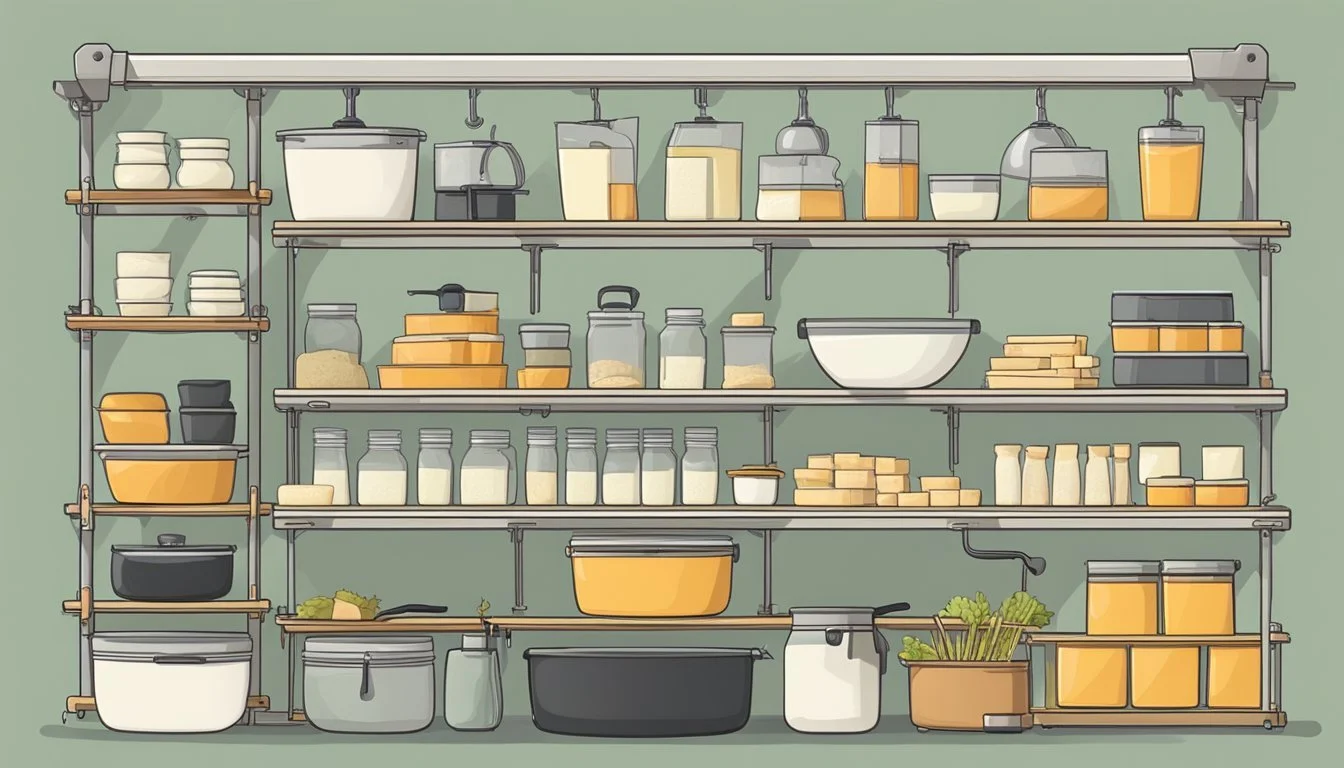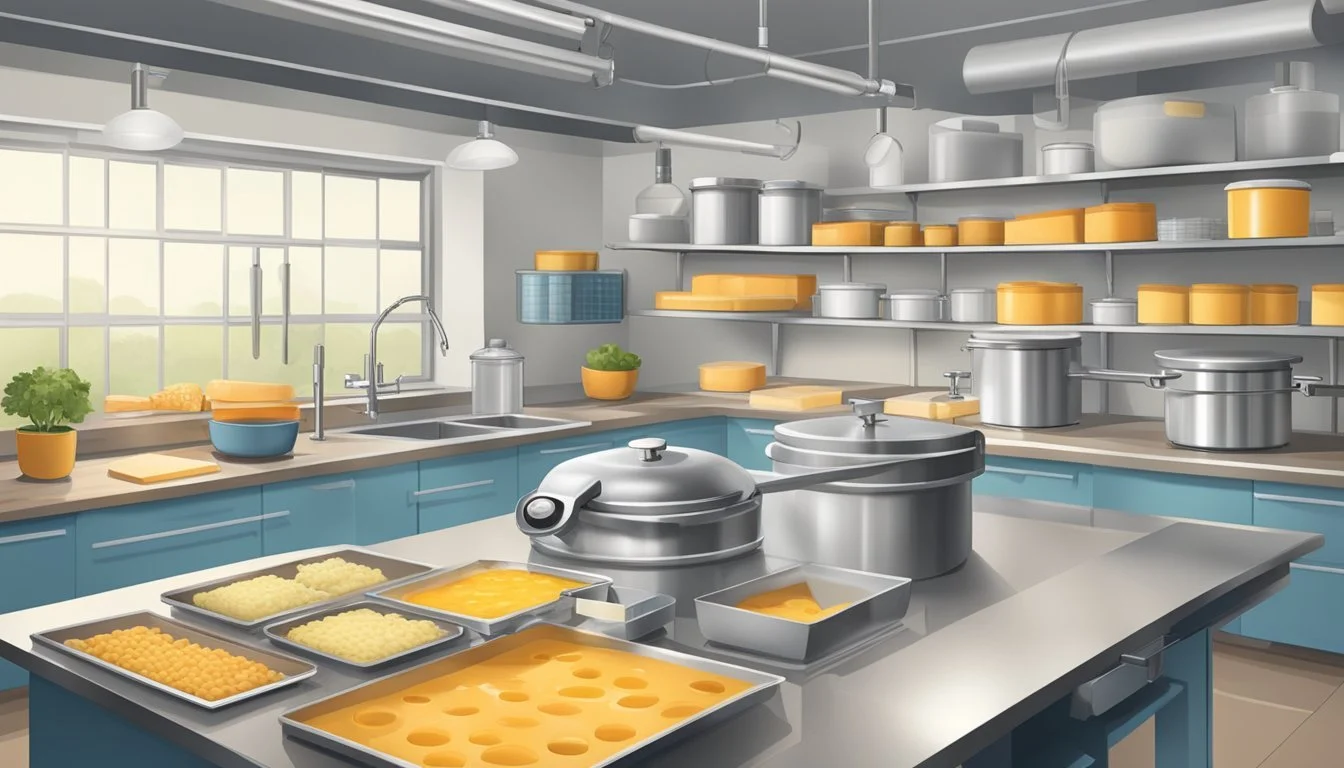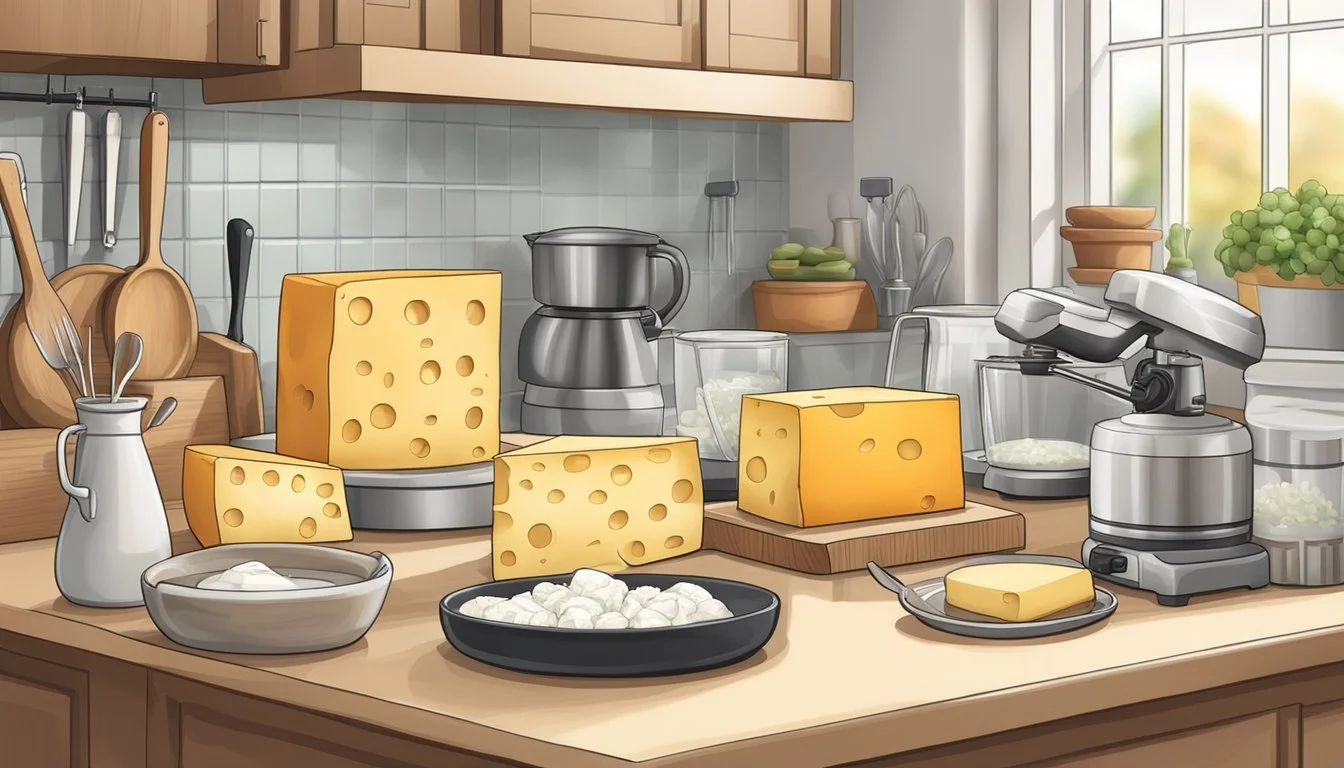How to Create an Organized Kitchen Cheese Making Station
Essentials and Layout Tips
Creating a specialized station in the kitchen for cheese making can transform a beloved hobby into an efficient and enjoyable practice. The key lies in organization, ensuring that all the necessary tools and ingredients are easily accessible, while maintaining a clean and safe environment suitable for cheese production. A designated area enables enthusiasts to streamline the process and keep their kitchens clutter-free.
An organized cheese (What wine goes well with cheese?) making station requires a thoughtful setup. It should be equipped with clean surfaces, storage for cultures and rennets, and a dedicated space for cheese molds and presses. Temperature control is essential, as many cheeses require specific conditions for aging. Therefore, organizing a station near a temperature-controlled storage area can be highly beneficial.
Proper equipment arrangement is crucial in a cheese making station. Utensils such as curd knives, thermometers, and cheese cloths should be stored together for convenience. Containers for storing milk and a space for the draining and pressing process are also important aspects of the station. This setup allows for an efficient workflow, helping to ensure that the art of cheese making remains a pleasurable and rewarding culinary venture.
Assessing Your Kitchen Layout
Before creating a cheese making station, it is crucial to evaluate the existing kitchen layout. The goal is to identify the most suitable area that allows for efficient cheese production without disrupting the kitchen’s flow.
Identifying the Ideal Location
The ideal location for a cheese making station should be away from high traffic areas to prevent cross-contamination and interruptions. One should consider proximity to the sink and refrigerator, as access to water and cold storage is pivotal. It is also important to choose a spot with relatively stable temperatures, as consistency is key in cheese making.
Maximizing Counter Space
Counter space is prime real estate in any kitchen, and even more so in a station dedicated to cheese making. Ensuring the counter height is appropriate, usually between 34 to 36 inches, can greatly reduce fatigue during the cheese making process. One may also contemplate installing additional countertop materials that are durable and easy to clean, like stainless steel or marble, which are beneficial for the cheese-making environment.
Kitchen Islands and Peninsulas
Kitchen islands and peninsulas offer an excellent solution for expanding work surfaces and can serve as the central hub for a cheese making station. Their placement in the kitchen should not interrupt the flow of work but should enable a dedicated area for specific tasks. Moreover, a kitchen island can provide additional storage solutions for cheese making tools and ingredients, keeping them organized and within reach.
Essential Cheese Making Tools
In creating an organized kitchen cheese making station, one must ensure they have the right tools at their disposal. Each tool performs a specific function that is critical in the cheesemaking process, from shaping the cheese to monitoring temperature and acidity.
Cheese Press and Molds
A cheese press is necessary for making hard cheeses and helps to apply even pressure to form the cheese and expel the whey. Different sized molds determine the final shape and size of the cheese. One must select non-reactive materials like stainless steel or food-grade plastic.
Hard Cheese Press: For pressing curds into solid cheese.
Cheese Molds: Various shapes and sizes for different cheese types.
Curd Cutting Knives
The curd must be cut uniformly to ensure even whey drainage and proper curd development. Curd cutting knives are designed to cut with precision and come in different shapes and sizes.
Curd Cutter: An essential tool for making a clean and even cut through the curd.
Curd Scoop Knife: Helps in gently scooping and transferring curd.
Thermometers and pH Meters
Precise temperature control is vital in cheesemaking, hence the use of a reliable thermometer. Similarly, a pH meter can be crucial for checking the acidity levels, which is necessary to achieve the desired flavor and texture.
Digital Thermometer: For accurate temperature measurement.
pH Meter: To track the acidity level during the cheesemaking process.
Organizing Ingredients and Supplies
When setting up an efficient kitchen cheese making station, carefully organizing ingredients and supplies is essential for a streamlined process. One needs to consider the storage of temperature-sensitive dairy, the accessibility of rennet and additives, and the arrangement of dry goods for a practical workspace.
Storing Dairy and Cultures
Dairy products, such as milk and butter, and starter cultures require refrigeration to maintain their freshness and prevent spoilage. The ideal solution is a dedicated refrigerator or a temperature-controlled section within your main fridge. Use clear, labeled jars or canisters to store cultures, ensuring they are sealed properly to avoid contamination.
Milk: in original containers or sealed pitchers.
Butter: wrapped in parchment or in a butter dish.
Cultures: in small, labeled jars.
Organizing Rennet and Additives
Rennet, both liquid and tablet forms, along with other necessary additives like salt and calcium chloride, should be arranged in close proximity to the work area. Rennet's efficacy can degrade over time, so it should be stored in a cool, dark place, usually in the refrigerator. Use small bottles or pre-measured packets for portion control, and mark the expiration date clearly on each container.
Rennet and Additives Storage:
Rennet: in the fridge, in its original dark bottle or airtight container.
Salt: in a shaker or bowl for easy sprinkling and measuring.
Additives: in clearly marked containers or packets.
Dry Storage Solutions
For the dry storage of non-perishable ingredients and cheesemaking tools, consider installing shelves or racks designed for easy access and visibility. This area can host a range of supplies from cheese molds to aging papers. The key is to ensure that these items are stored in a cool, dry place away from direct sunlight to preserve their quality.
Cheese molds and presses: on open shelving for accessibility.
Aging papers and cloths: in drawers or bins, sorted by size and type.
Non-dairy additives: on a spice rack or in a cabinet, grouped by use.
The organization of a cheese making station should be approached with attention to the unique requirements of each ingredient and supply to ensure a successful and enjoyable experience in cheese crafting.
Designing Your Cheese Making Station
Creating the ideal cheese making station requires a careful balance of functionality and design. It should cater to the specific needs of cheese production while ensuring ease of cleaning and maintenance.
Custom Build or Modify Existing
For those keen on a DIY project, the choice between constructing a new station or modifying an existing space in the kitchen is paramount. A custom build allows for tailoring every aspect to the cheese making process, whereas modifying an existing space can be a more cost-effective and less time-consuming option. Consider the workflow and the space required for equipment when deciding.
Choosing Durable Surfaces
Surfaces play a pivotal role in cheese making, thus marble, quartz, and stainless steel are excellent material choices. Marble stays naturally cool, making it perfect for the initial stages of cheese preparation. Quartz is non-porous, providing an easy-to-clean surface that resists bacteria. Stainless steel is durable and provides a professional look while ensuring cleanliness due to its non-reactive nature.
Material Benefits Considerations Marble Stays cool; ideal for dough rolling Can be pricey and requires sealing Quartz Non-porous; easy to clean Can be expensive; limited resistance to high heat Stainless Steel Durable; non-reactive Can show scratches and dents over time
Incorporating Sinks and Drains
A dedicated sink and proper drainage are critical for a cheese making station. They should be designed to handle the whey drainage and cleaning of large utensils like wooden spoons. Sinks made of stainless steel are recommended for their durability and ease of cleaning. Ensure that the sink is deep enough to accommodate large pots and has a strainer to capture curds before they enter the drain.
Storage and Accessibility
Creating an organized cheese making station in the kitchen revolves around two central principles: easy storage of tools and ingredients, and seamless accessibility to those items. The design of the station must account for the specific needs of cheese making, ensuring that tools are kept in pristine condition and ingredients are stored in a way to maintain their freshness.
Open Shelving vs. Closed Cabinets
Open Shelving: Ideal for frequently used items, open shelving makes ingredients like salts and starters easily visible and within reach. For a cheese making station, open shelves can be used to house clear jars of cultures and herbs, as well as small cheese molds for convenience. It’s important to maintain an organized appearance to avoid clutter.
Closed Cabinets: They provide a more controlled environment perfect for storing sensitive items that require protection from light and dust. Closed cabinets are best for larger equipment that's used less frequently, such as cheese presses or aging containers. A tidy cabinet prevents clutter and keeps the station looking neat.
Pullout Shelves and Drawers
Pullout Shelves: Shelves that can be pulled out from cabinets enhance accessibility and make it easier to retrieve and store items. They are especially useful for heavier equipment, allowing one to slide them out without strain. Pullout shelves fitted with dividers help keep tools orderly.
Drawers: They are indispensable for organization, perfect for storage of smaller tools like cheese knives, thermometers, and pH meters. Dividers or inserts in drawers can help segregate tools, making sure they are readily accessible and sorted by use or size.
Hanging and Wall Organizers
Hanging organizers keep items off countertops, freeing up workspace while still keeping tools within arm's reach. Wall-mounted racks or magnetic strips can hold metallic tools such as cheese wires or graters securely.
Wall organizers can serve multiple functions; they can be used to display recipes, or to store aprons and kitchen towels, thus minimizing clutter. They are a smart solution where counter space is limited and are an integral part of maintaining an orderly cheese making station.
Maintaining Cleanliness and Hygiene
An organized kitchen cheese making station ensures a contamination-free environment crucial for the quality of the cheese. Proper cleaning and sanitizing protocols for tools and surfaces are imperative for maintaining an optimal workflow.
Cleaning Protocols for Tools
One should begin with immersing all cheese making tools in hot soapy water to remove any debris. It is essential to rinse these tools with clean water to remove soap residue. For thorough sterilization, tools can either be boiled for at least 5 minutes or steamed. A pressure cooker can be used for stainless steel implements, with a typical sterilization period of 20 minutes at 257°F. Each tool, once cleaned, must be placed on a sanitized surface or in an organizer to prevent recontamination and to keep the workflow compact and efficient.
Surface Cleaning and Disinfection
The preparation surfaces must be cleaned and then sanitized with a suitable disinfectant solution to eliminate the risk of bacterial contamination. One can prepare a cleaning mixture by combining water with a small amount of household bleach in an atomizer. Application of this solution should be followed by a waiting period of one minute before wiping the surfaces with paper towels. Effective sanitation maintains a hygienic station and supports the correct handling of tools and ingredients during cheese making. Organizers and compact storage solutions should be situated conveniently to ensure that clean tools remain sterile and accessible.
Workflow Efficiency in Cheese Making
An organized kitchen cheese making station ensures streamlined workflow and maximizes productivity. It is crucial to have an efficient layout and proper time management to support the needs of a family or cheese making business.
Arranging Tools for Optimal Workflow
The arrangement of tools and supplies impacts overall efficiency in cheese making. Below is a strategic setup for a kitchen cheese making station:
Preparation Area: Centralize ingredients like milk, rennet, and cultures. Store them near the primary work surface.
Heating Equipment: Position pots and heating elements where they are accessible but not obstructive.
Draining Equipment: Place colanders, draining mats, and cheese moulds in an area close to the heating space.
Curing and Aging Space: Reserve a space for cheese to age, ensuring it is at the ideal temperature and humidity levels.
Time Management and Process Flow
Effectively managing time and process flow is vital in cheese making:
Scheduling: Utilize digital tools for meal planning, inventory tracking, and task scheduling. Implement reminders for important timing steps such as adding rennet or cultures.
Task Batching: Group similar tasks together to minimize setup and cleanup time. For example, cut all cheese curds in one session.
Process Monitoring: Keep digital thermometers and timers at hand to ensure precision in cooking times and stages.
By using technology and organizational techniques, one can achieve a balance between high-quality cheese production and efficient use of time and resources.
Compliance and Regulations
When setting up a kitchen cheese making station, one must navigate through various compliance standards and regulations to ensure the business operates legally and safely. These can include local cottage food laws and requirements for labeling and selling homemade cheese products.
Understanding Cottage Food Laws
Cottage food laws refer to regulations that allow individuals to produce and sell certain food products made at home. These laws vary by state and can significantly impact a cheese making business's budget and operations. They generally set the groundwork for what can be sold, where it can be sold, and how much revenue one can earn before needing a commercial license. It's essential for a business to review these laws in detail, as non-compliance can result in hefty fines or business closure.
Key considerations under cottage food laws may include:
Permitted types of cheese (e.g., aged vs. fresh)
Sales venues (e.g., farmers' markets, directly from home, online through a website)
Volume restrictions and revenue caps
Labeling and Selling Homemade Cheese
Once familiar with cottage food laws, a cheese maker must ensure that their products are correctly labeled before selling. Labeling regulations typically include listing all ingredients, potential allergens, and net quantity. The purpose is to provide transparent information to consumers, which can also be a marketing tool when communicated clearly through social media or a cheese business's website. Labeling must be factual and should not make unverified health claims.
To sell homemade cheese effectively, consider the following best practices in labeling:
Ingredients: List every ingredient in descending order by weight.
Allergens: Clearly identify common allergens like milk.
Net Quantity: State the amount of cheese in weight.
Business Information: Include the company name and contact information.
Special Attributes: If applicable, highlight family-friendly or unique selling points of the cheese.
Maintaining compliance with food safety regulations is critical. Ensuring an understanding of cottage food laws and proper labeling practices will help to establish a trustworthy and legally sound business.
Tips and Tricks
When creating a cheese making station in your kitchen, it's important to focus on functionality and clever storage solutions. These tips will help you make the most of your space and tools, ensuring an efficient and organized cheese making process.
Maximizing Small Space Functionality
For cheese enthusiasts working within limited kitchen real estate, the key to maximizing small spaces is to think vertically and make every inch count. Here are specific strategies:
Use Stackable Bins: These can hold ingredients and tools while taking up minimal footprint.
Wall-Mounted Shelves and Racks: Install these to store and organize cheese molds, cultures, and a strainer.
Pull-Out Drawers: They can be incorporated below workspaces for easy access to cheese cloths and thermometers.
Item Location Measurement Rennet and Culture Stackable bins Small containers Cheese Moulds Wall-mounted racks Varied sizes Thermometer Pull-out drawer Compact
Creative DIY Storage Ideas
She can think outside the box and use unique DIY solutions to keep her cheese making station tidy:
Repurposed Furniture: An old dresser's drawers could serve as a space for storing large pots or draining mats.
Magnetic Strips: A clever way to keep metal tools like cheese knives or spatulas within reach without using counter space.
Customized Labels: Clearly label bins and containers to identify contents quickly, which is especially useful for various types of milk or cultures.
Boldly labeling measurements on containers can save time.
Implementing a compact, designated workspace conducive to the phases of cheese making streamlines the process.









